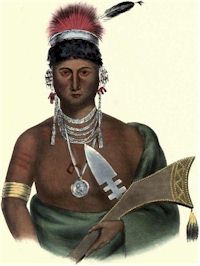
Signifies “A chief when a child,”
A Saukie Chief (Sauk)
This individual is one of the peace chiefs, and presides over a village of the Sauk. His name signifies “A chief when a child,” and indicates that his station was inherited. He was one of the delegation sent to Washington, in 1837, and, when at Boston, was said to have made the most animated speech, both in manner and matter, that was delivered by the chiefs. He said:
“You have heard just now what my chief has to say. All our chiefs and warriors are very much gratified by our visit to this town. Last Saturday they were invited to a great house, (Fanueil Hall,) and now they are in the great council-house. They are very much pleased with so much attention. This we cannot reward you for now, but shall not forget it, and hope the Great Spirit will reward you for it. This is the place which our forefathers once inhabited. I have often heard my father and grandfather say they lived near the sea coast where the white man first came. I am glad to hear all this from you. I suppose it is put in a book, where you learn all these things. As far as I can understand the language of the white people, it appears to me that the Americans have attained a very high rank among the white people. It is the same with us, though I say it myself. Where we live, beyond the Mississippi, I am respected by all people, and they consider me the tallest among them. I am happy that two great men meet and shake hands with each other.” As he concluded, Appanoose suited the action to the word, by extending his hand to Governor Everet, amid the shouts of applause from the audience, who were not a little amused at the self-complacency of the orator.
The newspaper account, from which we gather some of these facts, concludes with the following remark. “We have taken pains to give the speeches of the Indian chiefs with verbal accuracy, as a matter of high intellectual curiosity. History, romance, and poetry, have embodied the Indian character to our perceptions from child hood. It is pleasant, therefore, to see the original, and find how accurate the picture has been. The language, ideas, and style of these Indians are precisely such as have been ascribed to their race. There is much to admire in the simple and manly manner in which they convey their ideas. He must be but a churl who does not associate with their visit here, objects of philanthropy and protection to their race.”
